Cup-Incubation method
- Over the years we have tried out different incubation methods and setups.
- Currently we are using the Cup-Incubation method which works very well and is very handy.
- For this 2 clear plastic cups of different sizes are used. The smaller upper cup must fit tightly into the larger lower cup (see pictures below). Two such cups then form one Cup-Incubation unit.
- We use cups made of polystyrene. Cups made of this material wedge firmly into each other, and thus the upper cup sits firmly on the lower cup.
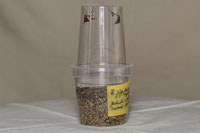
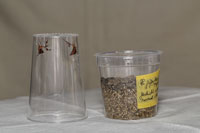
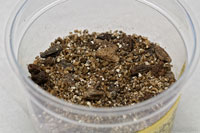
- One can also use so-called smoothie cups.
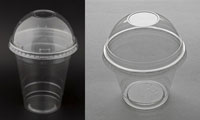
- Make some (needle) ventilation holes in the bottom of the upper cup, to avoid the formation of condensation within the cups.
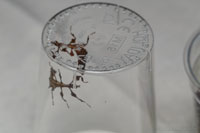
- Moisten the vermiculite with the appropriate amount of water - see instructions here. Use chlorine-free water to moisten the vermiculite.
- At the start of the incubation, note the culture's full name and the total weight (cup + vermiculite + water + eggs) on an adhesive tape (yellow in the pictures below). Use a digital letter scale for this.
- Water will evaporate from the cups via the ventilation holes in the upper cup. Therefore check the vermiculite once per month, whether it is still humid enough. Use again a digital letter scale.
- In my setup, about 6 g water evaporate per month.
- During this monthly check, the vermiculite is re-moistened with the appropriate amount of water, so that the vermiculite is neither too moist nor too dry.
- Eggs can be covered with a thin layer of vermiculite (2 - 3 mm high). This helps the nymphs to free themselves from the egg shell completely, and mould growth is somewhat reduced too.
- This Cup-Incubation method has a several advantages:
- Hatching nymphs have quite lot of space - thus lesser nymphs will be crippled.
- Each culture hatches in separate containers - thus cultures can not be confused with each other.
- Hatched nymphs are easily visible in a Cup-Incubation setup.
- Nymphs can be transposed directly with the upper cup into the breeding cage, which is less stressful for the nymphs.
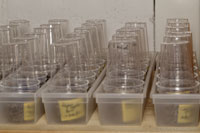
Fauna-Box setup, for species with big hatchlings
For species with very large hatchlings (eg Pharnacia, Phryganistria, Tirachoidea, Eurycnema) the cups used might be too small. For such species an Faunabox setup in combination with the Cup-Incubation method is recommended.
- Cup-Incubation unites are prepared as described above.
- In addition a larger opening is cut into the upper cup (use a stanley knife).
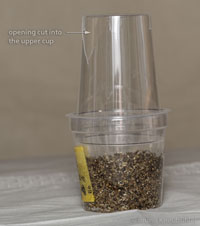

- Cup-Incubation units are placed inside a big Faunabox (or a similar cage).
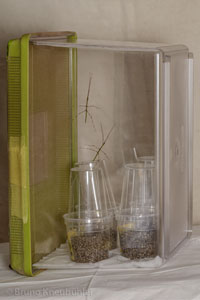
- Faunabox stands upright, and its floor is covered with wet kitchen paper.
- Keep this kitchen paper in the Fauna box constantly a bit moist.
- The upper half of the Faunabox lid is sealed with plastic so that a higher humidity can build up within the Faunabox.
- Hatching nymphs can easily escape through the hole in the upper cup into Faunabox. Thus they do not impede each other.
- As with this setup several species / cultures can hatch into the same Faunabox, one must ensure that hatchlings of similar cultures (e.g. pure populations of species which belong to the same genus) can not be confused with each other. Eggs of similar or closely related species / cultures must be incubated in separate Faunaboxes.